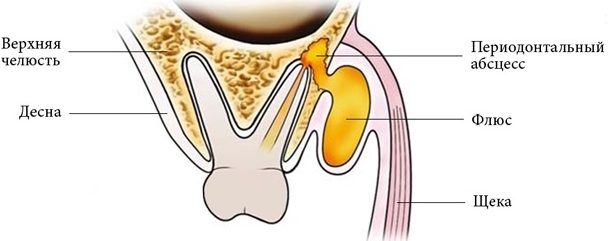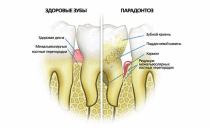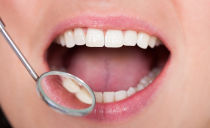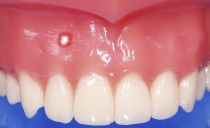A flux appeared: how to quickly remove a tumor at home
Flux is an inflammatory process in the periosteum and root of the tooth. Under its influence, the gum swells near the diseased tooth, and pus begins to accumulate in the surrounding tissues. If suppuration is not stopped in time, serious complications are possible - up to septic shock. With dental flux, you can quickly remove the tumor at home, but after that you should still consult a doctor.
Content
Causes and symptoms of dental flux
Flux is a household designation of periostitis or inflammation of the periosteum. The provocateur of the disease usually becomes an infection that penetrates into the bone tissue of the jaw from the root of a problem tooth or damaged gums. The inflammatory process can occur against the background of:
- complications after treatment at the dentist;
- ENT infections;
- deep caries;
- pulpitis;
- stomatitis;
- cysts on the root of the tooth;
- injuries
- periodontitis.
There are no obvious flux symptoms at the initial stage of infection. They begin to appear gradually, as the inflammatory process develops. The first sign of periostitis is the appearance of a noticeable swelling of the gums near the diseased tooth. After some time, the swelling on the cheek begins to hurt when touched or while chewing.
In the absence of treatment, the formation of a purulent sac on the gum or cheek begins. As pus accumulates, the abscess is constantly increasing. The best option at this stage is to consult a dentist who must clean the cavity and, if necessary, heal the tooth. The patient has symptoms of toxic poisoning: migraine, fever, nausea, vomiting, severe pain in the face.
In a good situation, the flux can break through on its own, and the pus will leave the cavity. But without the intervention of a dentist, the development of phlegmon is possible - purulent inflammation of the fiber and connective tissue. Pus will begin to spread throughout the body, affecting neighboring teeth and internal organs.
How a doctor treats dental flux
The dentist has several tasks: to clear the cavity of pus, relieve inflammation and, if possible, preserve the tooth. If the abscess has not yet begun, it is enough to clean the channels of the problem tooth, put a seal and choose the optimal antibiotics.
With a mature purulent capsule, it is necessary to cut the flux, remove the entire contents of the cavity and disinfect it. If necessary, a medicine is laid in the cavity, and drainage is installed on the gum, which allows for the outflow of pus. In addition, painkillers and antibiotics are prescribed, as well as special rinses or ointments.
If the inflammatory process lasts for a long time, and the root is seriously destroyed, after removal of the tumor, removal of the problem tooth may be required. The faster the patient visits dentistry, the less likely the development of complications.
Rinse solutions
Various antiseptic solutions help reduce swelling, slow down the inflammatory process and disinfect the oral cavity. They are used for rinsing or local processing of the problem area. After using them, the bacteria that cover the surface of the teeth also die.
Chlorhexidine has an excellent antiseptic effect: it allows you to fight with any microorganisms that can cause pathological processes in the oral cavity, and contributes to the rapid healing of tissues with flux. For rinsing, it is better to use a 0.5% solution, the procedure should be carried out every 2-3 hours.
You can also use:
- hydrogen peroxide;
- Betadine;
- Rotokan.
Peroxide disinfects the oral cavity, destroys bacteria and “draws out” pus. In its pure form, it is not recommended to use liquid: the solution is diluted with boiled chilled water in 1: 1 proportions. Rinse your mouth with peroxide every hour. If the tooth hurts due to inflammation, the syndrome should quickly recede.
Betadine can quickly relieve swelling with tooth flux. It contains iodine - a well-known antiseptic. The tool affects the focus of inflammation, disinfects tissues and promotes the outflow of purulent fluid. A solution is prepared for rinsing: 20 ml of Betadine is added to 200 ml of water. It must be used at least 3-4 times a day.
Rotokan is a herbal alcohol infusion. It includes calendula, sage and chamomile. Each of these plants has natural anti-inflammatory, decongestant, and antiseptic properties. Before rinsing, the Rotokan is diluted with water (20 ml per glass), the product is suitable only for the treatment of flux in adults.
Anti-inflammatory drugs
With the help of pharmacy rinses and folk remedies, you can only temporarily dull the symptoms of periostitis. To stop the inflammatory process, it is necessary to resort to medical treatment.
Flux can be treated with the following medicines:
- Ibuprofen: quickly relieves heat, removes pain and relieves inflammation. Effective after 20-30 minutes after administration. Available in two forms: conventional tablets and suspension.
- Nimesil: reduces swelling, eliminates pain and affects the focus of inflammation. The maximum daily dosage is 300 mg; it is not recommended to give the drug to children.
- Diazolin: contains substances that can relieve the symptoms of allergies - swelling and pain. The dosage is determined individually, depending on the age of the patient and the stage of development of the flux.
- Ketonal DUO: struggles with temperature, inflammation and pain. The maximum daily dosage is two tablets. A noticeable effect should occur during the first two days of admission.
The optimal duration of the anti-inflammatory course is five days. But only a doctor can determine the exact time, so it is undesirable to decide how and how to remove the tumor from the flux on the cheek. Drinking a course of tablets is necessary even if the obvious swelling was able to be removed using simple rinses.
Dental flux treatment with antibiotics
When antibiotics are used at the initial stage of the flux, you can not only quickly stop inflammation, but also prevent the appearance of an abscess. A good effect of the drug is given at an early stage, when the gum has just begun to swell. After opening the abscess, such drugs are necessary to stabilize the condition, accelerate recovery and prevent repeated complications.
Amoxiclav
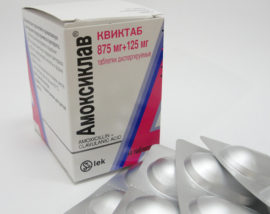 Amoxiclav is a film-coated tablet containing amoxicillin and clavulanic acid (potassium salt). Amoxiclav refers to broad-spectrum antibiotics, inhibits gram-negative and gram-positive bacteria, as well as gram-negative anaerobes.
Amoxiclav is a film-coated tablet containing amoxicillin and clavulanic acid (potassium salt). Amoxiclav refers to broad-spectrum antibiotics, inhibits gram-negative and gram-positive bacteria, as well as gram-negative anaerobes.
The drug is suitable for the treatment of patients older than twelve years. Dosage depends on the concentration of active substances and the condition of the patient. The maximum allowable daily dose of potassium salt for adults is a maximum of 600 mg. The course of treatment lasts at least five days and can be extended.
During pregnancy or feeding, Amoxiclav can be used only when the possible benefits of its use exceed the expected harm.You will have to give up the drug if you have individual intolerance to the components, problems with the kidneys or liver, mononucleosis or lymphocytic leukemia.
Biseptol
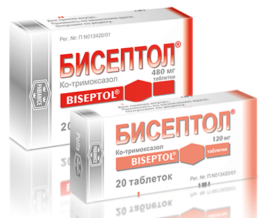 Biseptol is a combined drug, which is based on sulfamethoxazole and trimethoprim. It affects the protein metabolism in microbial cells, disrupting the process of their division and reproduction. Effective against gram-positive and gram-negative anaerobes.
Biseptol is a combined drug, which is based on sulfamethoxazole and trimethoprim. It affects the protein metabolism in microbial cells, disrupting the process of their division and reproduction. Effective against gram-positive and gram-negative anaerobes.
Dosage is determined taking into account the age of the patient. For children from three to five years, the drug is prescribed two tablets twice a day, a child from six to twelve years old needs to take four tablets twice a day. Adults are recommended to drink 960 mg of the drug twice a day. The average duration of therapy is about a week.
If the patient has kidney failure, the dosage is halved. The drug has many contraindications: lactation, pregnancy, sensitivity to components, kidney and liver diseases, blood diseases.
Dental flux treatment at home
After dental flux treatment in dentistry, you can remove residual edema at home using traditional medicine recipes. They cannot completely replace drug therapy, but they can accelerate the healing process.
The possibility of using non-traditional methods of therapy should be discussed with your doctor. They can give the best effect at the initial stage of the development of pathology, until a purulent sac forms.
If your gums are swollen, try preparing the simplest saline-soda rinse. It has an anti-inflammatory effect and stops the formation of pus, and also cleanses the oral cavity of bacteria. In a glass (200 ml) of warm water you need to take half a teaspoon of each component. To enhance the effect, a drop of iodine is added to the composition.
If you are forced to postpone a visit to the dental office, rinse your mouth with a herbal decoction. Fit:
- calendula;
- coltsfoot;
- sage;
- plantain;
- chamomile.
You can use either a single plant or a mixture of several ingredients. A teaspoon of dry grass is poured with boiling water and warmed up in a water bath for 10-15 minutes. When the liquid has cooled to room temperature, the broth is filtered and used to rinse the mouth.
If the sac has already formed, and a large tumor has appeared on the face, you need to “stretch” the purulent contents to save the tooth. To do this, you need a small sheet of fresh cabbage. It is poured with boiling water to soften or carefully knead with a fork. A small piece is applied to the problem area for 15–20 minutes. You can change the sheet an unlimited number of times.
Even if you manage to remove the flux tumor using traditional methods or pharmacy drugs, visit your dentist. Any inflammatory processes in the face are very dangerous and can cause damage to the entire body.


